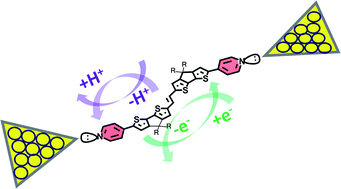Synthesis and electronic properties of pyridine end-capped cyclopentadithiophene-vinylene oligomers†
Abstract
A series of four oligomers of cyclopentadithiophene-vinylenes end capped with pyridine groups was prepared and their optical and electronic properties studied. Treatment with trifluoroacetic acid (TFA) leads to the bisprotonation of the nitrogens of the pyridine, which has an important impact on the optical properties. Excess treatment with TFA provokes the oxidation of the conjugated core, generating radical cations and dications. The ease of the TFA treatment in solution was extended to protonation in the solid-state where further characterization of the neutral and TFA-treated samples was carried out in electrically active substrates in organic field-effect transistors. Finally, the new molecules were found to be excellent conductors in single-molecule junctions thanks to strong electron delocalization and resonance orbital mediated transport. These studies show the opening of a spectrum of possibilities by suitable terminal substitution of π-cores.



 Please wait while we load your content...
Please wait while we load your content...